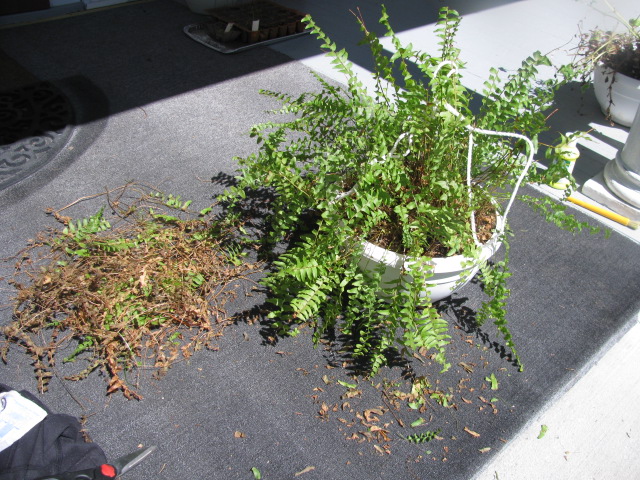To over-winter a Boston Fern, bring it indoors and place it in a cool, bright location with high humidity. Boston ferns are popular indoor and outdoor plants that thrive in the warm months but may struggle with the cold temperatures of winter.
As the temperature drops, it’s important to take steps to ensure the survival of your Boston Fern. While these plants are not frost tolerant, there are methods to over-winter them successfully. In this guide, we will explore how to properly care for Boston Ferns during the winter months, allowing them to survive and thrive until the warmer weather returns.

Credit: plantaddicts.com
By following these steps, you can enjoy the beauty of your Boston Fern year-round and keep it healthy and vibrant during the winter season.
How to Over Winter a Boston Fern : Step by Step Guide
Choosing The Right Time For Overwintering
Determining the ideal time to start preparing your Boston fern for winter requires an understanding of the specific climatic conditions that influence the overwintering process. Boston ferns are tropical plants that thrive in warm and humid environments, so it is important to consider the unique needs of these plants when planning for overwintering.
Typically, it is recommended to begin the process in late summer or early fall, before the temperatures drop significantly. This allows the fern to gradually acclimate to the changing conditions and ensures a smoother transition into the winter months. However, it is important to monitor the weather patterns in your specific region, as frost and freezing temperatures can vary. By selecting the appropriate time to start overwintering, you can help your Boston fern survive the colder months and flourish once spring arrives.
Preparing Your Boston Fern For Winter
To over winter a Boston Fern, it is important to prepare the plant properly. One crucial step is trimming and pruning the fern foliage. This helps to remove any damaged or diseased fronds, making the plant healthier for winter.
Cleaning and disinfecting the fern’s container is also essential to prevent the spread of any pests or diseases. Inspecting the fern for pests and treating any infestations promptly is another important task. This can be done by examining the leaves and stems for signs of pests such as spider mites or scale insects, and then using appropriate treatment methods.
Providing The Optimal Environment For Overwintering
Providing the optimal environment is crucial for overwintering your Boston fern. Start by identifying the best indoor location for your fern. Choose a spot that offers suitable humidity levels, as ferns thrive in moist environments. Positioning the fern in a room with indirect sunlight is ideal, ensuring it receives adequate light without exposure to cold drafts.
Avoid placing it near doors or windows that are frequently opened. Use a humidifier or place a tray with water near the fern to maintain the necessary humidity levels. Monitor the temperature in the room and avoid extreme fluctuations. Investing in a thermometer can help you keep track. With proper care and attention to its environment, your Boston fern can successfully survive through the winter months.
Watering And Feeding During The Winter Months
During the winter months, it is crucial to make adjustments to the watering frequency and amount for your Boston Fern as it goes into its dormant period. Decreasing the frequency of watering is necessary as the plant’s growth slows down. However, maintaining adequate moisture levels is still important to keep the fern healthy. It is recommended to water the plant only when the top inch of the soil feels dry to the touch.
Another aspect to consider when caring for your Boston Fern during winter is its nutrient needs. Choosing the appropriate fertilizer and application method is essential for nourishing the fern. Opt for a balanced fertilizer with equal parts nitrogen, phosphorus, and potassium. Apply the fertilizer according to the package instructions, usually every two to three months.
Monitoring the moisture levels in the fern’s soil is essential to prevent overwatering. Avoid allowing the soil to become waterlogged, as this can lead to root rot. Consider using a moisture meter to accurately determine the moisture content in the soil and adjust your watering accordingly.
Monitoring And Troubleshooting
A Boston Fern is a popular houseplant, but it requires special care during the winter months. Monitoring and troubleshooting are essential to ensure its survival. Observing the fern’s overall health and growth throughout the winter is crucial. Keep an eye out for common issues such as yellowing leaves, fungal infections, or pests. If you notice yellowing leaves, it may be a sign of overwatering or insufficient light.
To remedy this, adjust the watering schedule and provide adequate light. Fungal infections can be treated with a fungicide specifically designed for ferns. Prevent pests by regularly inspecting the plant for any signs of infestation and using organic sprays as necessary. It’s important to implement these effective remedies and preventative measures to ensure the fern’s well-being during the winter months.
Transitioning The Boston Fern For Spring
Boston Ferns are a popular houseplant, but they can also be transitioned to outdoor conditions during the spring. When transitioning the fern outside, it’s essential to do it gradually to avoid shock or adjustment issues. Start by placing the fern in a shady, protected area for a few hours each day, gradually increasing the time spent outside over the course of a few weeks. This will help the fern acclimate to the outdoor conditions.
Once the fern is fully transitioned outdoors, resume regular watering, fertilizing, and maintenance practices. Keep in mind that ferns prefer moist soil, so make sure to water them regularly and provide good drainage. Fertilize the fern every month during the growing season to promote its growth and vitality. Regularly inspect the fern for any signs of pests or diseases and address them promptly to keep the plant healthy.
Overall, transitioning a Boston Fern for spring requires patience and careful evaluation of the fern’s conditions to ensure its successful adaptation to outdoor conditions.
Frequently Asked Questions Of How To Over Winter A Boston Fern
How Do I Save My Ferns For Next Year?
To save your ferns for next year, follow these steps: 1. Cut back the foliage to about 2 inches above the soil. 2. Place the fern in a cool, dark area like a basement or garage. 3. Water sparingly to prevent the soil from drying out completely.
4. Inspect the plant regularly for pests or diseases. 5. In spring, gradually acclimate the fern to brighter light and begin regular watering.
How Do You Make A Boston Fern Dormant?
To make a Boston fern dormant, expose it to cooler temperatures around 50-55°F (10-13°C) and reduce watering. Place it in a darker location with less sunlight, and avoid fertilizing during this period. This will allow the fern to rest and prepare for future growth.
Can You Keep Boston Ferns Inside Over The Winter?
Yes, Boston ferns can be kept inside during the winter. They thrive in indoor environments, but make sure they receive adequate indirect sunlight and are kept in a humid atmosphere. Water them regularly and avoid placing them near heaters or drafty areas.
How Do You Winterize Ferns In Pots?
To winterize ferns in pots, move them indoors to a cool, well-lit area away from drafts. Reduce watering frequency and avoid overwatering during the dormant period. Trim off any dead or dying fronds. Protect the ferns from direct heat sources and provide humidity by using a pebble tray or misting.
Conclusion
In a nutshell, caring for your Boston fern during the winter months is essential to ensure its survival and growth. By following the simple steps discussed in this blog post, you can successfully overwinter your fern and enjoy its vibrant green foliage year-round.
Remember to provide adequate light, maintain consistent humidity levels, and protect it from harsh temperatures. With proper care, your Boston fern will thrive and bring a touch of nature to your indoor space. Happy gardening!

